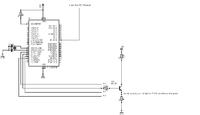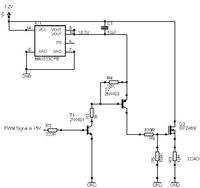ScratchBuild
Member level 2
- Joined
- Nov 8, 2006
- Messages
- 51
- Helped
- 2
- Reputation
- 4
- Reaction score
- 0
- Trophy points
- 1,286
- Location
- South Africa
- Activity points
- 1,705
Hi there,
Can you please help me. I am not at all a professional in electronics and have a problem I am sure you have a quick answer too.
I have written some code on a 16f877 that reads a servo signal and accordingly changes the PWM duty cycle. I do not have a problem with the PWM signal coming out from the PIC. I have checked it on my scope and it is near perfect square and works OK.
I now feed this signal into a KB817 optocoupler and the strange thing is it then just jumps from 0 to full volts. I cannot detect my pwm signal on the other side (transistor). I first had it on 19.53 KHz and thought the frequency maybe too high for the optocoupler and lowered it to 4.3KHz. But still the same problem. Can anyone please give me some explanation and maybe which optocoupler I should use then.
Regards
Nic
Can you please help me. I am not at all a professional in electronics and have a problem I am sure you have a quick answer too.
I have written some code on a 16f877 that reads a servo signal and accordingly changes the PWM duty cycle. I do not have a problem with the PWM signal coming out from the PIC. I have checked it on my scope and it is near perfect square and works OK.
I now feed this signal into a KB817 optocoupler and the strange thing is it then just jumps from 0 to full volts. I cannot detect my pwm signal on the other side (transistor). I first had it on 19.53 KHz and thought the frequency maybe too high for the optocoupler and lowered it to 4.3KHz. But still the same problem. Can anyone please give me some explanation and maybe which optocoupler I should use then.
Regards
Nic

